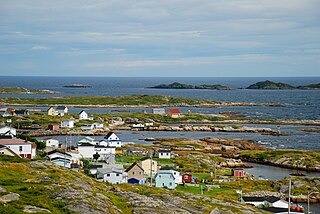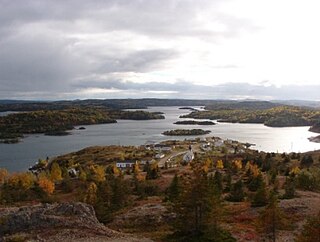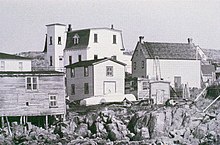
Bonavista is a town on the Bonavista Peninsula, Newfoundland in the Canadian province of Newfoundland and Labrador. Unlike many Newfoundland coastal settlements, Bonavista was built on an open plain, not in a steep cove, and thus had room to expand to its current area of 31.5 km2 (12.2 sq mi). Bonavista is located approximately 300 km from the provincial capital of St. John's.
Newtown is a part of the Municipality of New-Wes-Valley, located at the North end of Bonavista Bay in the province of Newfoundland and Labrador, Canada. The approximate population is 400. Settlement in Newtown originated around 1850 when people relocated from nearby areas. Newtown is well known for being built on many small islands, and is the home of the Barbour Living Heritage Village.

Cabot Tower is a tower in St. John's, Newfoundland and Labrador, situated on Signal Hill. Construction of the tower began in 1898 to commemorate the 400th anniversary of John Cabot's discovery of Newfoundland, and Queen Victoria's Diamond Jubilee.

Greenspond is a community in the province of Newfoundland and Labrador, Canada.
James Ryan businessman, oldest of seven sons and two daughters of Mary Ellen Fleming and Michael Ryan was born in Bonavista, Newfoundland.

The Masonic Temple built in 1894 at St. John's, Newfoundland, Canada is an example of Victorian construction which includes pilasters, free-standing columns and multiple pediments. The Masonic Temple was designated a Registered Heritage Structure by the Heritage Foundation of Newfoundland and Labrador in April 1995.

Quidi Vidi is a neighbourhood in St. John's, Newfoundland and Labrador. The village is adjacent to Quidi Vidi Lake. Quidi Vidi's harbour is known as "The Gut". Located in Quidi Vidi is the Quidi Vidi Battery Provincial Historic Site. The village is home to several small businesses.

Anderson House is a wooden, two and one half storey hip roofed heritage-designated building located at 42 Powers Court, St. John's, Newfoundland and Labrador. It is a Vernacular Georgian style building and is reported to be one of the oldest structures in the city of St. John's.

Trinity is a small town located on Trinity Bay in Newfoundland and Labrador. The town contains a number of buildings recognized as Registered Heritage Structures by the Heritage Foundation of Newfoundland and Labrador.

Pilley's Island is a town located on the island of the same name in the Canadian province of Newfoundland and Labrador. It is located in Division No. 8, Newfoundland and Labrador.
Admiralty House is a one-storey, wooden gable-roofed, municipally-designated heritage building originally built as a wireless communications station in Mount Pearl, Newfoundland and Labrador, Canada. It currently serves as a museum and archives. The building is purported to be the last standing of 11 such identical stations built around the world during the First World War.

Clarke's Beach is a town on Conception Bay in the Canadian province of Newfoundland and Labrador. In the 2021 census the town had a population of 1,400. It is the home of a number of well-known Newfoundland artists, and is a favourite place for retirement.
The architecture of St. John's, in Newfoundland and Labrador, Canada, has a style distinct from that of the rest of Canada, and its major buildings are remnants of its history and prestige as the first British colonial capital. The city of St. John's has had a long history, with inhabitation dating to the 16th century onwards. As the city grew, so, too, did the landscape. Buildings took a variety of styles according to the styles and means available to build the structures. Starting as a fishing outpost for European fishermen, St. John's consisted mostly of the homes of fishermen, sheds, storage shacks, and wharves. Of course, these structures were small and constructed out of wood. Like many other cities of the time, as the Industrial Revolution took hold and new methods and materials for construction were introduced, the landscape changed as the city grew in width and height. The Great Fire of 1892 destroyed most of the downtown core, and most residential and other wood-frame buildings date from this period. Often compared to San Francisco because of its hilly terrain and steep maze of residential streets, housing in St. John's is typically painted in bright colours, unlike most other parts of Canada.

The St. John’s Court House is located on Water Street and Duckworth Street in St. John’s, Newfoundland and Labrador. Constructed in 1901–04, the building is a National Historic Site of Canada. Sources differ with regard to its architect; it was designed either by William Tuff Whiteway or by William H. Greene.

Cape Bonavista Light is a lighthouse located on Cape Bonavista, Newfoundland. The lighthouse, which operated from 1843 until 1962, is now a provincial museum, containing an exhibition about life in a lighthouse during the 1870s.

O'Reilly House is a museum located in Placentia, Newfoundland and Labrador, Canada. It was built for Magistrate William O'Reilly who served as Magistrate of Placentia from 1897-1923. He was the son of Thomas O'Reilly who had been the magistrate of Placentia from 1877-97. In 1902, Magistrate O’Reilly employed the architect W.J. Ellis to build a Balustrade Queen Anne Victorian house that would serve as his family home.
The Green Family Forge is a two-storey, wooden, heritage-designated blacksmith shop located at the intersection of West Street at Dandy Lane in Trinity, Trinity Bay, Newfoundland and Labrador.
Ridley Hall is the site of a circa 1834 stone residence located on Water Street, Harbour Grace, Newfoundland and Labrador. The building, which received heritage designation in 1994, remained vacant for many years and in 2003 it was almost completely destroyed by fire. As of 2021, it survived as a ruin.

Mallard Cottage is a heritage-designated building located within Quidi Vidi Village in the City of St.John's, Newfoundland and Labrador. The cottage is a one-and-a-half-stories with a hipped roof and central chimney. The architecture is an example of early 19th century vernacular style patterned on Irish thatched-roofed cottages. Though the exact date of construction cannot be confirmed, based on evidence from construction techniques, architectural style, and oral history the date for its construction are placed between 1820 and 1840, making it one of the oldest residential structures in St. John's. Two other buildings in St.John's of the same style are Anderson House, built 1804–1805, and Martin McNamara House, exact construction date unknown. These three structures are the best preserved examples of late 18th and early 19th century architecture in St.John's.
A by-election was held in the federal riding of Bonavista—Burin—Trinity in Newfoundland and Labrador on December 11, 2017 following the resignation of Liberal MP Judy Foote. The seat was held for the Liberals by Churence Rogers.














